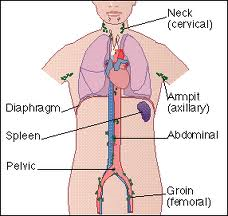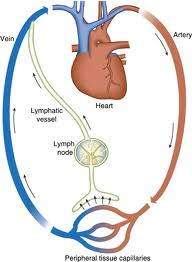Introduction
Background of the Study
The lymphatic system is part of the cardiovascular transport system which aids in fat digestion and its transport into the liver and other storage sites in the body. In addition, the lymphatic system supports other body immune functions. It is also involved in the transport of interstitial fluid and other important dietary constituents such as proteins from the rest of the body particularly in the extracellular space to the cardiovascular system (Brooker & Brooker, 1996, p.247).
When the lymphatic system is damaged or its vessels are blocked, accumulation of the lymph occurs especially at the lower part of the body such as the limbs which also acts as the initial lesion of elephantiasis (Brooker & Brooker, 1996, p.247).
Aim
This report evaluates how the lymphatic system as a part of the human transport system works about its various functions.
Scope
The report entails a description of the structure and functions of the lymphatic system in addition to the process of lymph formation in the human body. In addition, the report describes the interrelationship between the circulatory and lymphatic systems.
The Human transport System
The structure and functions of the lymphatic system
The lymphatic system develops after 5-6 weeks of pregnancy during fetal development. It originates from the first archaic veins and comprises jugular and iliac veins which form a meshwork of capillaries. Findings of studies indicate that most of the tissues and organs of the system are mesodermal apart from the thymus which is endodermal. At childbirth, the only lymphoid tissue which is fully developed is the spleen while the other tissues appear later in life, especially during infancy and childhood. Lymphocytes are then introduced into the lymph nodes and other tissues of the system at this stage (Brooker & Brooker, 1996, p.248).

The above diagram is an illustration of the different components of the lymphatic system and their respective locations. The system comprises blunt-ended tiny vessels known as the lymph capillaries which form a network of vessels around cells or the extracellular space. Their main function is to collect the interstitial fluid from the interstitium into the lymphatics. The capillaries form a network within the body except in the CNS and bones (Brooker & Brooker, 1996, p.249). Their walls are designed in such a way that they can allow free movement of micro-organisms, hormones, water, some nutrients, waste products, cells, and proteins into the vessels. However, their structure does not allow movement of the absorbed materials out of the vessels. Other vessels such as the lacteals are designed specifically for the absorption and transportation of fats in form of chyle to the circulatory system. The small vessels merge giving rise to lymph vessels which are similar to veins. However, the only difference with the veins is that they have additional valves which prevent the backflow of the lymph. These vessels convey their contents to the lymphatic and thoracic ducts which lead to the circulatory system (Brooker & Brooker, 1996, p.250).
Formation of the Lymph
Most of the fluid resulting from capillary filtration is not reabsorbed into the veins. This fluid comprises approximately 90-95% of the lymphatic fluid. The cells produce the rest of the fluid through their metabolic processes. In a normal human being, metabolic processes can give rise to about 150-300 milliliters of water per day (Brooker & Brooker, 1996, p.248). This forms part of the interstitial fluid which is found in the extracellular fluid. The ECF, cell debris, proteins, and whole cells in the interstitium enters the lymphatics through the lymph capillaries. Other materials enter the system through a process referred to as pinocytosis. This occurs via the endothelial walls of the lymphatic. The amount of lymph that is formed depends on the ambient temperature and the state of the body as during physical exercise large volumes of the fluid are collected. It is estimated that up to 2-3 liters of the lymph fluid are channeled into the veins per day (Brooker & Brooker, 1996, p.249).
The interrelationship of the circulatory and lymphatic systems
The lymphatic system is referred to as an open transport mechanism. The diagram below illustrates the interrelationship between the lymphatic and circulatory systems. The lymphatic system works in juxtaposition with the circulatory system in many ways. The system accepts the interstitial fluid from the extracellular fluid and transports it back into the circulatory system. In this way, it prevents incidences of accumulation of tissue fluid. Inside the lymph vessels, the collected fluid which is referred to as lymph moves through several compartments such as the lymph nodes which contain lymphocytes that kill harmful micro-organisms in the fluid (Berne, 1992, p. 1).

Other organs of the lymphatic system such as the spleen are charged with the responsibility of eliminating the dead blood cells and other micro-organisms from the circulatory system (Berne, 1992, p.2).
Conclusions
The report gives a comprehensive analysis of the structure and functions of the lymphatic system. It also outlines the process of lymph formation in addition to the interrelationship existing between the lymphatic and the circulatory systems. From the above discussion, it is conclusive that the lymphatic system is an important component of the human transport system. This arises from the fact that the system performs several different functions. For example, the lymphatic system aids in various body immune mechanisms such as killing harmful micro-organisms. In addition, it also acts as the main channel for fat absorption into the body.
Reference List
Berne, R.M & Levy, M.N. 1992. Cardiovascular Physiology, C.V. Mosby, St. Louis.
Brooker, C. & Brooker, C. 1996. Nursing applications in clinical practice: human structure and function. London, UK: Mosby International Limited.